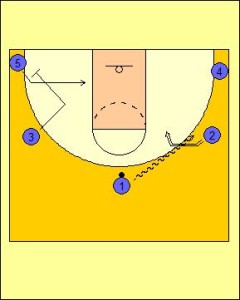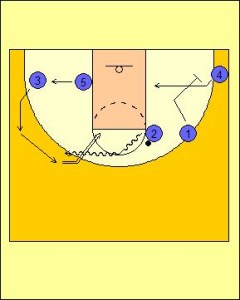Open Post Offense: Hand-off Switch
The Open Post Offense provides the much needed space that undersized teams need to create scoring opportunities. Through motion offense principles and a quickened player movement tempo the Hand-off Switch Play looks to bring an opposition’s defence unravelled.
The Open Post Offense Hand-off Switch Play looks to expose the defence by moving players rapidly around the half court. The cutting players off the ball however, never move into the keyway unless the dribbler is first in a driving lane. This means the help position players are never able to sit in the keyway in a help position. This provides additional distance to a defensive players sprint to help which ultimately provides a great advantage to the offense.

The standard formation for the Open Post Offense is for all five players to be outside the keyway. The Hand-off Switch Play looks to start with the interior players (Four and Five), who are usually poor ball handlers, on the baseline. These players are not engaged in the hand-off sequence and therefore limit the dangers associated with them.
The limiting positioning of Four (4) and Five (5) however is replaced with these players being screened into cutting positions closest to and around the keyway.
One (1) starts with the ball in the Point Position. One (1) dribbles to either side to initiate a hand-off with the player in the wing position (Two).
Two (2) looks to attack the basket following the hand-off.
One the weak side of the floor Three (3) fakes a cut to the basket before screening for Five (5). Three (3) must ensure that following the cut to the fake cut to the basket that the defensive player is screened and not just going through the motions of the offenses pattern.
Five (5) attacks the basket off of the screen. If possible Five (5) should look to beat the defensive player to the keyway and then hold a seal with the defensive player on their back away from where the dribbler (Two) will be attacking.
Variation:
If Three (3) on the fake to the basket, beats their player then a full cut to the basket can be executed. In this instance Five (5) would lift up the sideline to then be involved with Two (2) in the hand-off rotation on the opposite side of the floor.
Scoring Options:
- Two (2) off of the hand-off
- Three (3) is defensive reads is an open cut to the basket
- Five (5) cutting off of screen

Two (2) must keep their head up off of the dribble to see the movement of the offensive players on the weak side of the floor. Five (5) will be in a very good receiver spot during the ball handlers (Two) drive to the basket.
If Two (2) cannot find a driving lane to the basket off of the hand-off, then the same offensive tactic will be executed on the opposite side of the floor.
Two (2) dribbles across the keyway raising to the meet the hand-off recipient (Three) at the elbow extended position.
Five (5) replaces back to the long corner.
One (1) looks to fake cut to the basket and in doing so creates a better angle for the screen for Four (4).
Three (3) looks to receive the hand-off and then drive into the keyway.
Four (4) using the screen set by One (1) cuts to the basket and into a receiver spot for the possible assist by Three (3) off of the dribble.
Four (4) should look to beat the defensive player to keyway and then hold inside position for a better passing opportunity from the dribbler (Three).
The Open Post Offense Hand-off Switch Play looks to spread the floor and create openings in the defence’s help positions. The Open Post Offense is fantastic in helping shift players, especially interior players, out of their regular defensive positions and forcing them to guard on the perimeter.







Leave a Reply